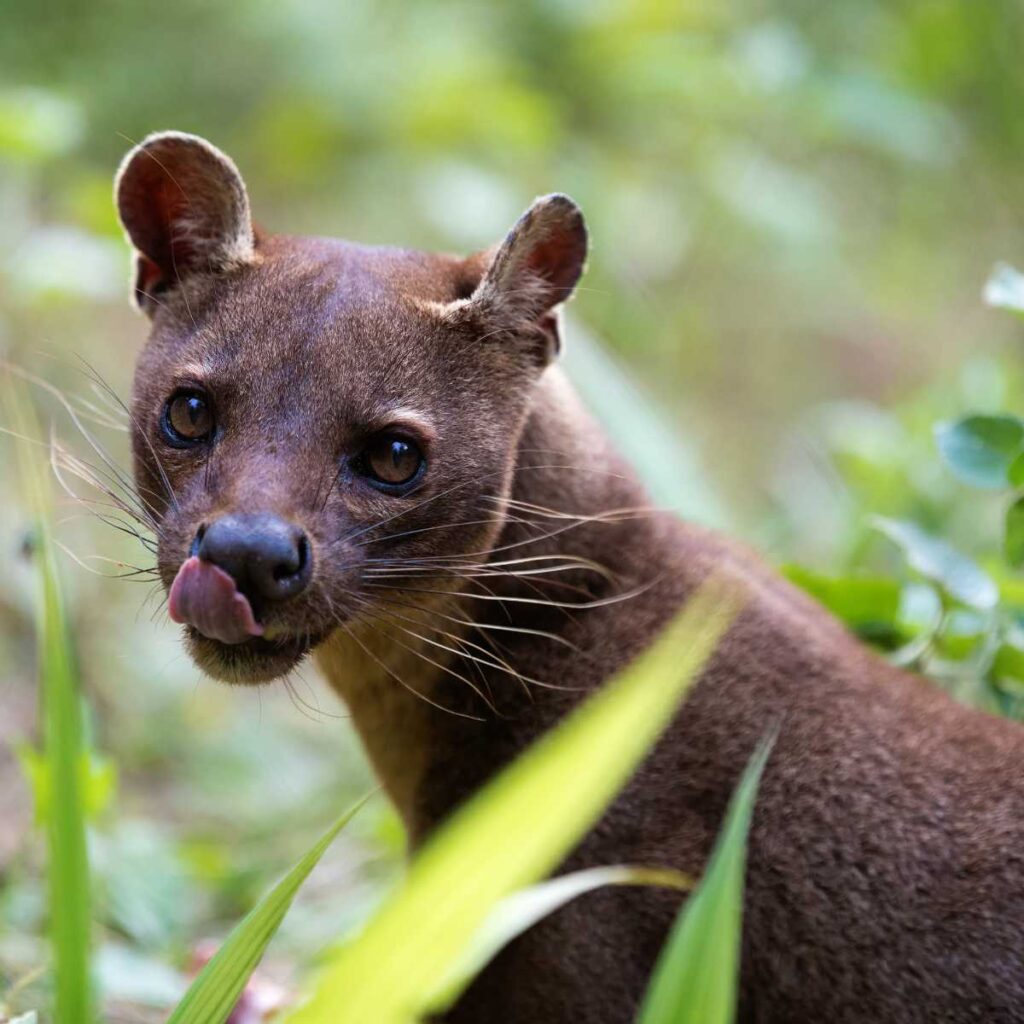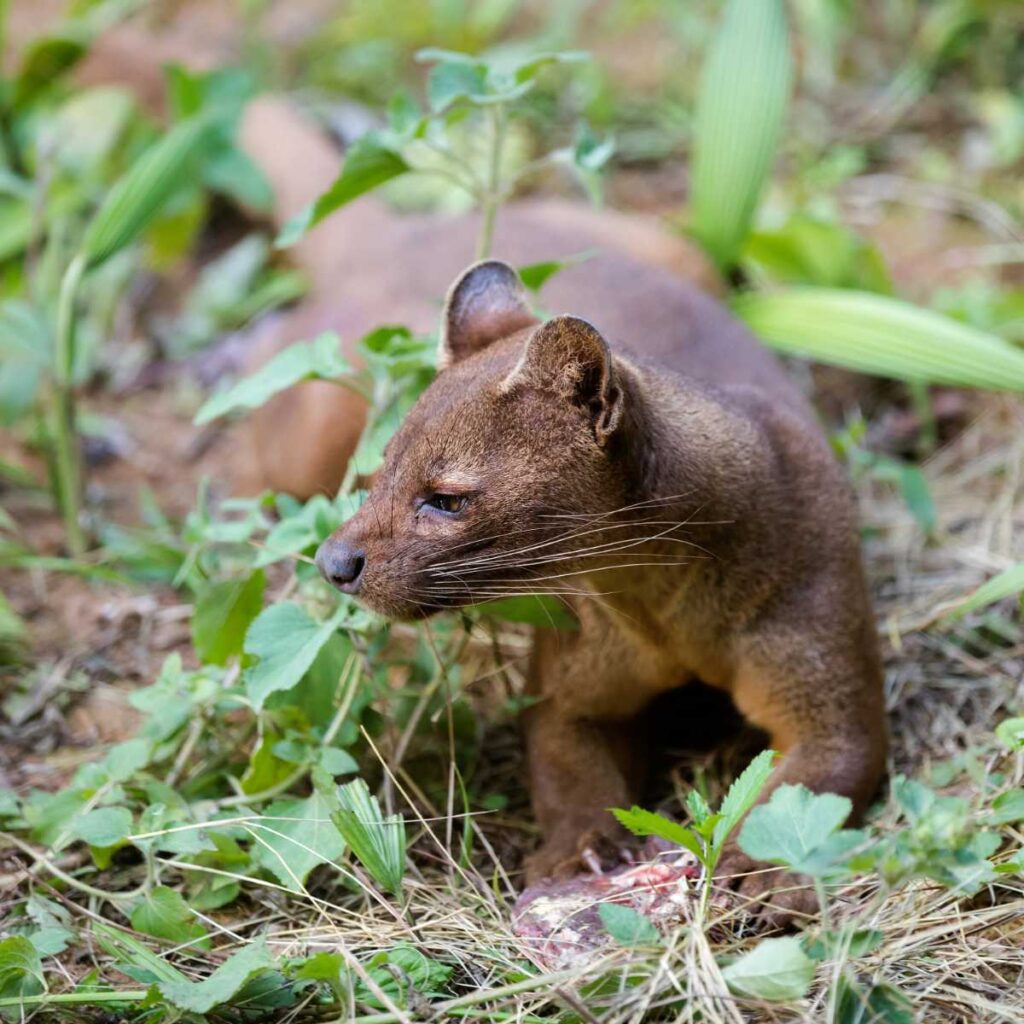Last Reviewed and Updated on February 26, 2023
The fossa is a unique carnivorous mammal that is native to Madagascar and is one of the top predators on the island. Explore some of the most intriguing and little-known facts about fossa, including their fun name origin and unusual mating dynamics. Fossa is a genuinely fascinating creature that will captivate anyone interested in the natural world.

About Fossa
The fossa, Cryptoprocta ferox, is a carnivorous mammal that is native to the island of Madagascar (off the east coast of Africa), where it lives in forested habitats.
The fossa has a long, slender body that is about the size of a small to medium-sized dog. Adults are about 28-31 inches / 70 to 80 centimeters in length and weigh between 12 to 19 lb / 5.5 kg to 8.6 kg, with males being larger than females. It has short, reddish-brown fur, a long tail (nearly as long as its body), and powerful jaws with sharp teeth. Another notable feature is its rounded ears. Fossa resembles a small cougar.
Their physical traits made the classification of fossa controversial; they resemble cats; however, other traits suggest they are more closely related to viverrids (civets, binturongs) than they are to cats. Through genetic studies, they have been classified as Eupleriade, a family of carnivorans endemic to Madagascar (all carnivores on Madagascar are more closely related to each other than to other mammals).
The fossa is a formidable predator that preys upon a variety of animals, including lemurs, rodents, reptiles, and birds. It is an agile and stealthy hunter, able to leap from tree to tree and pounce on its prey with great speed and accuracy. It is also known to be a scavenger, feeding on the carcasses of larger animals.
While they are active both during the day and night and are considered cathemeral, meaning their activity interval is irregular.
Fossas have litters of one to six pups. Except for mating and mothers caring for their young, fossa is solitary.
The fossa conservation status of the fossa is classified as vulnerable; their greatest threat is habitat loss.
Interesting Facts About Fossa
Read through these fun facts about fossa and learn what makes these carnivores unique.

1. The fossa is the largest predator on Madagascar
Madagascar’s wildlife is unique because over 80% of its plant and animal species are found nowhere else on Earth. The island has been isolated for millions of years, allowing for the evolution of many distinct and unusual species. The fossa is the largest predator on the island.
Fossa is the apex predator as it is at the top of the food chain in Madagascar.
2. Its scientific name means “hidden butt”
“Cryptoprocta ferox” is the scientific name of the Fossa, and the name refers to the fossa’s anus hidden by its anal punch. “Cryptoprocta” literally means “hidden anus” in Ancient Greek (crypto meaning hidden, procta meaning anus). “Ferox” is a Latin word meaning “fierce” or “ferocious,” which is a fitting description for this agile and solitary predator.
Wondering what fossa means? The name “fossa” derives from the word fosa in Malagasy (Austronesian language), and the word is similar to posa in the Iban language, which means cat. It is also possible the name fossa is derived from Malay pusa.
3. Fossa have semi-retractable claws
Semi-retractable claws help fossa easily climb trees; they also have flexible ankles that make grasping tree trunks a breeze. Their long tail also assists them with balance.
The claws are semi-retractable, as, unlike cats, the fossa’s claws aren’t hidden in skin sheaths.
4. They have a taste for lemurs
Fossa prey on a variety of small and medium-sized animals. Lemurs comprise over 50% of their diet, and they can tackle lemurs that are almost the size of the fossa itself.

5. Juvenile fossas are gray or nearly white
While adult fossa has red-brown fur, its young have gray or almost white fur. They are also born blind and toothless.
6. They usually mate on trees
Fossas mate with a view! The mating usually occurs on tree branches at about six ft / 20 meters off the ground. Mating on the ground has also been observed.
7. They also like to use the same tree
When you find a perfect tree, you keep it. Female fossas will frequently use the same tree to mate on year after year.
8. Their mating process is unique in carnivores
A female doesn’t show a preference for any physical traits of males; she does, however, choose the males she mates with. During the mating, the female will occupy her tree for up to a week, and she may mate with multiple males and even multiple times with the same male. A single mating may last for up to three hours, which is unusually long. Other females may occupy the same spot and mate with the same males.
9. Fossas have a unique genitalia
Male fossas have unusually large penises and penis bones. When females are about one or two years old, they develop a penis-looking clitoris, which isn’t unique in the animal kingdom; however, unlike any other species, the size of the baubellum (the bone inside) decreases in size as she ages.
10. Fossa can purr
Purring is a soft, rumbling sound made by some animals, including cats and other members of the cat family. While not super closely related to cats, fossas are capable of purring.
Fossas communicate using a variety of vocalizations, body language, and scent markings.
